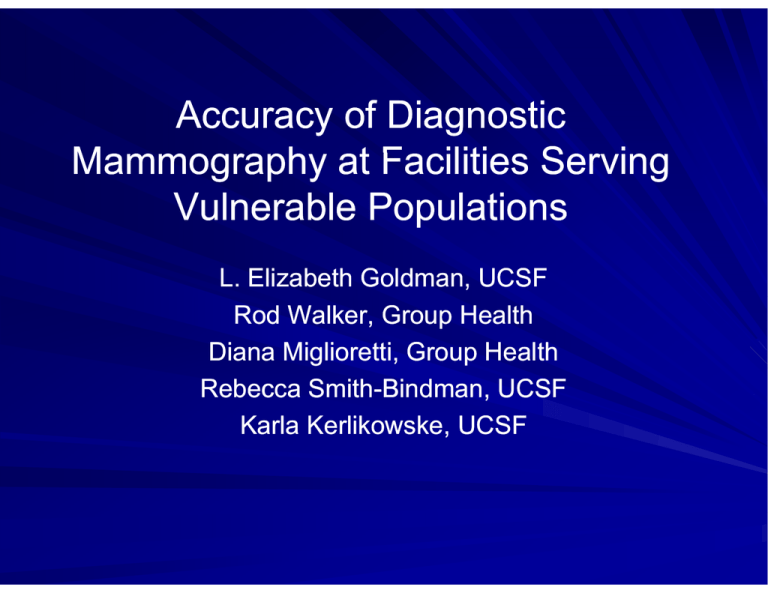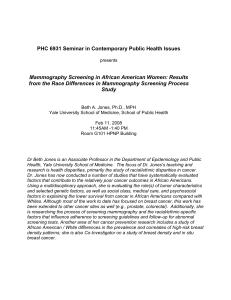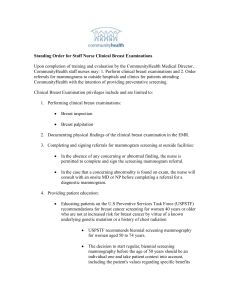Accuracy of Diagnostic M h t F
advertisement

Accuracy of Diagnostic M Mammography h att F Facilities iliti S Serving i Vulnerable Populations p L. Elizabeth Goldman, UCSF Rod Walker, Group Health Diana Miglioretti, Group Health Rebecca Smith Smith--Bindman, UCSF Karla Kerlikowske, UCSF Breast cancer disparities Mortality M t lit rates t for f breast b t cancer are higher hi h in i vulnerable l bl populations Biologic differences in breast cancer by race Documented disparities in treatment and treatment delays by race/ethnicity, insurance status, & income Facility-level differences in diagnostic accuracy of Facilitymammography h could ld contribute t ib t tto di diagnostic ti d delays l or unnecessary diagnostic procedures Variability in mammography interpretive performance Diagnostic interpretive performance differs across mammography h ffacilities iliti Due to patient mix, skill of radiologists, equipment, and practice patterns Research Question Does the interpretive performance of diagnostic mammography differ between facilities serving vulnerable women and those serving nonnonvulnerable women? Breast Cancer Surveillance Consortium Methods Study period: 19991999-2005 Subjects: j – Women age 4040-80 – Diagnostic mammography Additional evaluation of abnormal screening mammogram Evaluation of a symptomatic breast problem Outcomes Sensitivityy False positive rate (1 – specificity) Cancer detection rate = number cancers detected per 1,000 diagnostic mammograms *Cancer: Invasive carcinoma or DCIS within 1 year of *Cancer: diagnostic mammogram Definition of a facility serving vulnerable women < 83% have at least a high school education > 30% AfricanAfrican-American, Hispanic, Pacific--Islander/Hawaiian, Pacific Islander/Hawaiian Native American < $45,000 average median household income > 52% rural residents *composite score: sum of 4 binary vulnerability measures Goldman, Medical Care, 2008 Results: Study Population Additional evaluation of a recent abnormal screening mammogram Evaluation of a symptomatic breast problem NonNonvulnerable (score = 0) Non-vulnerable Non(score = 0) Moderately vulnerable (score = 1 or 2) Highly vulnerable (score = 3 or 4) Moderately vulnerable (score = 1 or 2) Highly vulnerable (score = 3 or 4) # of facilities 62 63 28 77 70 29 # of women 43,305 25,904 6,990 44,538 21,195 8,501 # of diagnostic mammos 47,609 28,372 7,483 52,050 23,193 9,544 Results: Study Population Facilities serving vulnerable women – Women tended to be older – Without prior mammography or very distant mammography (> 43 months) – More positive final interpretations Additional evaluation of abnormal screening mammogram, adjusted* Sensitivity Non--vulnerable Non Vulnerable Education Race/ethnicity / 87.8% 87.8% % 84.7% 83.5% % 0.77 0.70 (0.44, 1.34) ( (0.37, 1.31)) 0.346 0.263 Rural/urban residences Income 87.7% 88 6% 88.6% 87.2% 83 4% 83.4% 0.96 (0.61, 1.50) 0 64 (0 0.64 (0.40, 40 1 1.02) 02) 0.850 0.060 0 060 86.0% 82.7% 84.2% 93.2% Reference 0.72 (0.45, 1.15) 0.56 (0.32, 0.98) 0.62 (0.33, 1.19) 1.64 (0.34, 7.97) TREND 0.164 0.042 0.150 0.537 0.610 Composite vulnerability score 0 1 2 3 4 89.4% OR (95% CI) p-value * Adjusted Adj t d for f age, breast b t density, d it time ti since i last l t screening i mammogram, BCSC site Additional evaluation of abnormal screening mammogram, adjusted* Non--vulnerable Non Vulnerable OR (95% CI) p-value Education Race/ethnicity 10.3% 10 3% 10.3% 10.1% 10 1% 10.4% 0.97 0 97 (0 (0.76, 76 1 1.24) 24) 1.01 (0.76, 1.35) 0.827 0 827 0.928 Rural/urban residences Income 9.8% 9.6% 11.0% 12.8% 1.14 ((0.94, 1.38)) 1.39 (1.13, 1.70) 0.175 0.002 10.4% 12.0% 11.9% 11 9% 9.6% Reference 1.11 (0.91, 1.37) 1.32 (1.02, 1.70) 1 30 (0 1.30 (0.96, 96 1 1.76) 76) 1.02 (0.63, 1.66) TREND 0.309 0.038 0.092 0 092 0.943 0.723 False Positive Rate Composite vulnerability score 0 1 2 3 4 9.4% * Adjusted for age, breast density, time since last screening mammogram, BCSC site Additional evaluation of abnormal screening mammogram, adjusted* Non-vulnerable Non(per 1000 exams) Vulnerable (per 1000 exams) Education Race/ethnicity 30.3 30.4 27.1 26.0 0.89 0.85 (0.69, 1.15) (0.63, 1.15) 0.360 0.285 Rural/urban residences Income 28.4 30.5 32.5 27.6 1.15 (0.94, 1.41) 0.90 (0.72, 1.12) 0.161 0.345 27.7 28.1 27.7 44.1 Reference 0.87 (0.70, 1.08) 0.88 (0.68, 1.16) 0.87 (0.64, 1.19) 1.42 (0.84, 2.40) TREND 0.213 0.370 0.393 0.185 0.216 0 216 Cancer Detection Rate Composite vulnerability score 0 1 2 3 4 31.6 OR (95% CI) p-value * Adjusted for age, breast density, time since last screening mammogram, BCSC site Evaluation of breast symptoms symptoms, adjusted* adjusted S Sensitivity ii i N -vulnerable NonNon l bl V l Vulnerable bl Education Race/ethnicity 81.9% 81 9% 81.5% 79.8% 79 8% 81.1% 0.87 0 87 0.97 (0 (0.63, 63 1 1.20) 20) (0.67, 1.42) 0.400 0 400 0.888 Rural/urban residences Income 80.4% 81.6% 83.5% 80.9% 1.24 (0.93, 1.66) 0.95 (0.70, 1.29) 0.139 0.751 82.5% 81.3% 79 4% 79.4% 87.9% R f Reference 1.10 (0.78, 1.55) 1.01 (0.69, 1.48) 0 89 (0 0.89 (0.60, 60 1 1.32) 32) 1.72 (0.70, 4.20) TREND 0.595 0.958 0.561 0 561 0.232 0.358 Composite vulnerability score 0 1 2 3 4 81 2% 81.2% OR (95% CI) p-value l * Adjusted for age, breast density, time since last screening mammogram, site Evaluation of breast symptoms symptoms, adjusted* adjusted NonN Nonvulnerable V l Vulnerable bl Education Race/ethnicity 6.1% 6 1% 6.2% 8.2% 8 2% 8.0% 1.39 1 39 1.32 (1 (1.08, 08 1 1.79) 79) (0.98, 1.76) 0.011 0 011 0.066 Rural/urban residences Income 5.7% 6.0% 8.5% 7.8% 1.55 (1.27, 1.88) 1.34 (1.08, 1.66) <0.001 0.008 6.9% 7.3% 8.8% 10.6% R f Reference 1.31 (1.06, 1.63) 1.39 (1.08, 1.78) 2.12 (1.27, 2.32) 2.12 (1.36, 3.32) TREND 0.014 0.011 0.001 0.001 0.001 F l Positive False P ii R Rate Composite vulnerability score 0 1 2 3 4 5.4% 5 4% OR (95% CI) p-value l * Adjusted for age, breast density, time since last screening mammogram, site Evaluation of breast symptoms (adjusted) Non-vulnerable Non(per 1,000 exams) Vulnerable (per 1,000 exams) Education Race/ethnicity 36.5 35.9 39.6 44.3 1.09 1.25 (0.88, 1.35) (0.98, 1.60) 0.440 0.069 Rural/urban residences Income 34.6 35.6 42.9 41.0 1.26 (1.05, 1.50) 1.16 (0.97, 1.40) 0.011 0.110 38.3 41 2 41.2 41.2 45.9 Reference 1.15 (0.94, 1.41) 1 25 (0 1.25 (0.99, 99 1 1.57) 57) 1.28 (0.98, 1.67) 1.40 (0.91, 2.14) TREND 0.169 0.058 0 058 0.070 0.122 0.102 0 0 Cancer Detection Rate Composite vulnerability score 0 1 2 3 4 33.5 OR (95% CI) p-value Limitations Income based on ZIP code average, may not represent individual woman’s true income Income is absolute and purchasing power may vary across the United States Conclusions Facilities serving low income women are more likely to recommend biopsy after diagnostic mammography performed to evaluate abnormal screening mammograms Facilities serving low income income, rural rural, and minorities are more likely to recommend biopsy after diagnostic mammography performed to evaluate breast symptoms Cancer detection similar between facilities serving vulnerable and nonnon-vulnerable women Policy Implications Interventions to improve interpretive performance of diagnostic mammography at facilities serving vulnerable women may reduce invasive procedures in women without cancer Increased referral rates for biopsy may be appropriate in settings with both higher cancer prevalence and higher lost to followfollow-up rates Future Work Determine D t i if iincreased d rates t off recommendation d ti for biopsy among women without cancer (false positives) actually lead to more biopsies in women without cancer Evaluate facility characteristics that may contribute to differences in referral patterns for biopsies Evaluate whether referrals “appropriate” Acknowledgments California Breast Cancer Research Project Project, Grant #14IB #14IB0062 AHRQ KO8,, Grant #1 K08 HS018090-01 National Cancer Institute Breast Cancer Surveillance Consortium (U01CA63740, U01CA86076, U01CA86082, U01CA63736 U01CA70013 U01CA69976 U01CA63736,U01CA70013, U01CA69976, U01CA63731, U01CA70040) The collection of cancer data used in this study was supported in part by several state public health departments and cancer registries throughout the U.S. For a full description of these sources, please see: htt //b http://breastscreening.cancer.gov/work/acknowledgemen t i / k/ k l d t.html.





